Johnson R.S. A Modern Introduction to the Mathematical Theory of Water Waves
Подождите немного. Документ загружается.

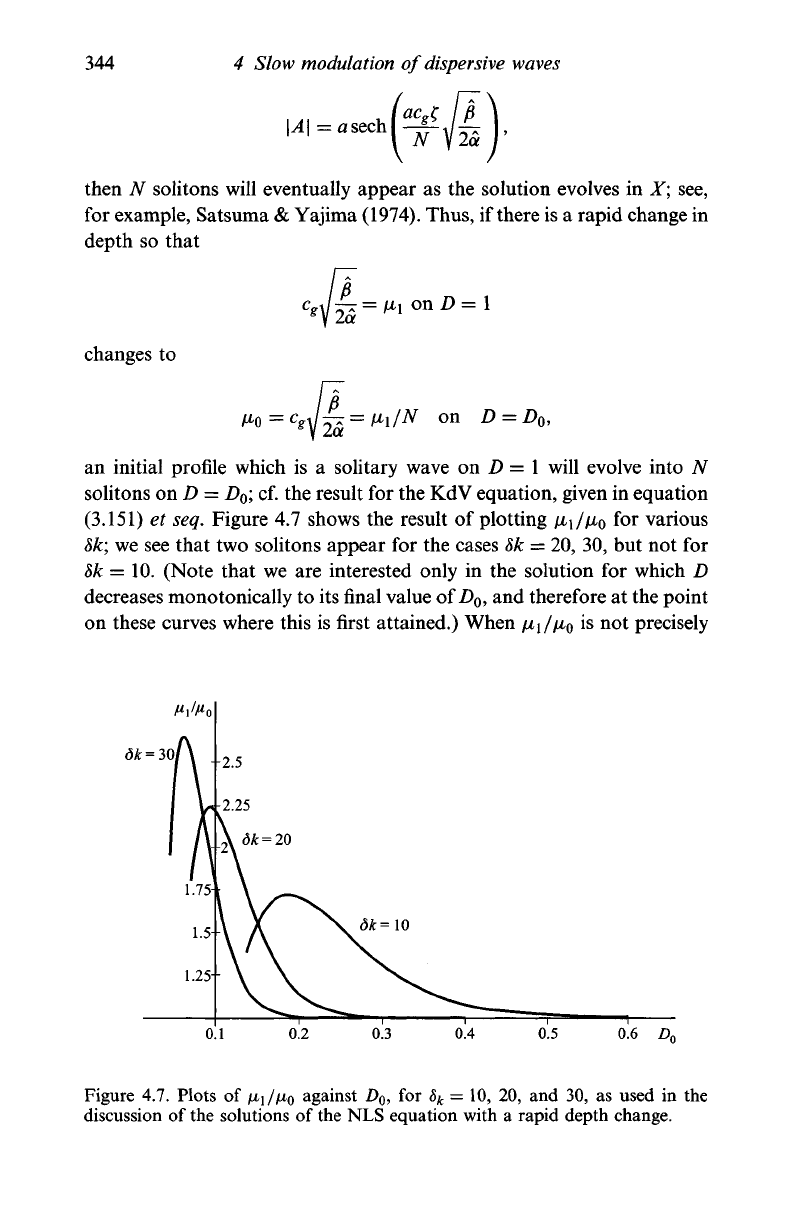
344
4 Slow modulation of dispersive waves
\A\
— flsech
then N solitons will eventually appear as the solution evolves in X; see,
for example, Satsuma & Yajima (1974). Thus, if there is a rapid change in
depth so that
changes to
on D =
an initial profile which is a solitary wave on D = 1 will evolve into N
solitons on D = D
o
; cf. the result for the KdV equation, given in equation
(3.151) et seq. Figure 4.7 shows the result of plotting jLti//x
0
for various
8k; we see that two solitons appear for the cases 8k = 20, 30, but not for
8k = 10. (Note that we are interested only in the solution for which D
decreases monotonically to its final value of
Z>
0
,
and therefore at the point
on these curves where this is first attained.) When
/JLI/JJLQ
is not precisely
Figure 4.7. Plots of /AJ/ZZQ against D
o
, for 8
k
= 10, 20, and 30, as used in the
discussion of the solutions of the NLS equation with a rapid depth change.
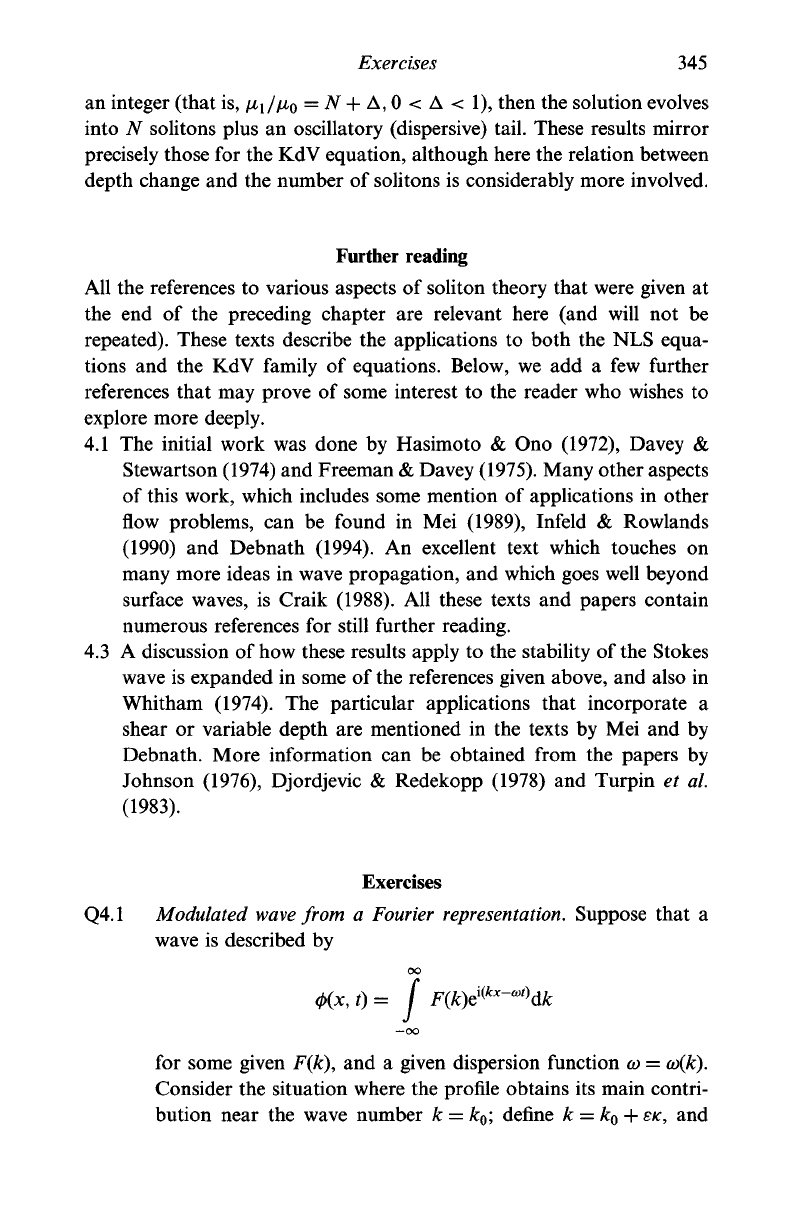
Exercises 345
an integer (that
is,
/^//XQ = N + A, 0 < A < 1), then the solution evolves
into N solitons plus an oscillatory (dispersive) tail. These results mirror
precisely those for the KdV equation, although here the relation between
depth change and the number of solitons is considerably more involved.
Further reading
All the references to various aspects of soliton theory that were given at
the end of the preceding chapter are relevant here (and will not be
repeated). These texts describe the applications to both the NLS equa-
tions and the KdV family of equations. Below, we add a few further
references that may prove of some interest to the reader who wishes to
explore more deeply.
4.1 The initial work was done by Hasimoto & Ono (1972), Davey &
Stewartson (1974) and Freeman
&
Davey (1975). Many other aspects
of this work, which includes some mention of applications in other
flow problems, can be found in Mei (1989), Infeld & Rowlands
(1990) and Debnath (1994). An excellent text which touches on
many more ideas in wave propagation, and which goes well beyond
surface waves, is Craik (1988). All these texts and papers contain
numerous references for still further reading.
4.3 A discussion of how these results apply to the stability of the Stokes
wave is expanded in some of the references given above, and also in
Whitham (1974). The particular applications that incorporate a
shear or variable depth are mentioned in the texts by Mei and by
Debnath. More information can be obtained from the papers by
Johnson (1976), Djordjevic & Redekopp (1978) and Turpin et al
(1983).
Exercises
Q4.1 Modulated
wave
from a
Fourier
representation.
Suppose that a
wave is described by
oo
for some given F(k), and a given dispersion function
co
=
co(k).
Consider the situation where the profile obtains its main contri-
bution near the wave number k
—
k
0
; define k = k
0
+
SK,
and
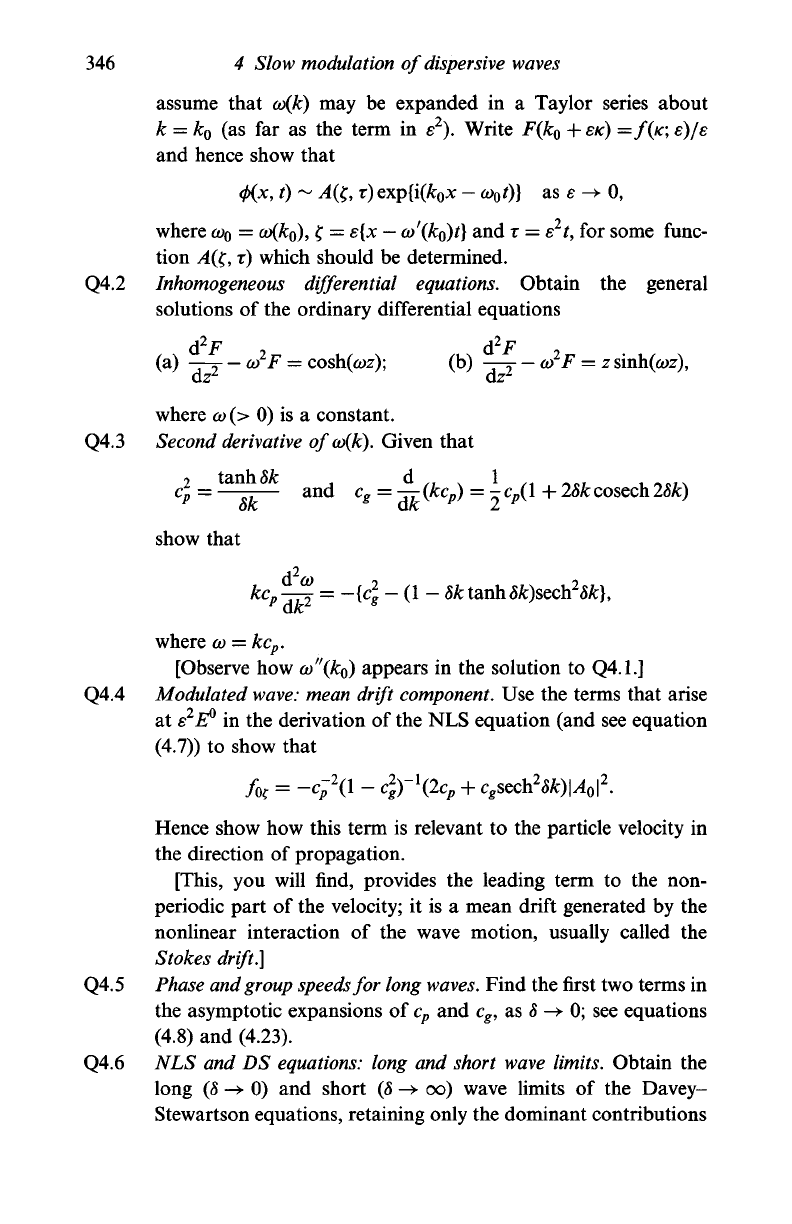
346 4 Slow
modulation
of
dispersive
waves
assume that
co{k)
may be expanded in a Taylor series about
k = k
0
(as far as the term in s
2
). Write F(k
0
+
SK)
=/(*:; e)/e
and hence show that
0(JC,
i) ~
A(t;,
r) exp{i(fc
o
x
—
co
0
t)}
as £ -» 0,
where o;
0
=
o)(k
0
),
l;
= e{x -
co'(k
0
)t]
and r = e
2
t, for some func-
tion
A(i;,
T)
which should be determined.
Q4.2 Inhomogeneous differential equations. Obtain the general
solutions of the ordinary differential equations
d
2
F
2
d
2
F
2
(a)
—-IT
— (o
F =
cosh(coz);
(b) —-^
— co
F = z
sinh(coz),
dz
z
dz
L
where
cy
(> 0) is a constant.
Q4.3 Second
derivative
ofco(k). Given that
and
c
g
=^{
,^7T =
~{c
2
g
-
(1
- <5fctanh<M:)sech
2
<$A;},
show that
where
<w
= fcc^.
[Observe how
co"(k
0
)
appears in the solution to Q4.1.]
Q4.4 Modulated
wave:
mean drift
component.
Use the terms that arise
at s
2
E° in the derivation of the NLS equation (and see equation
(4.7)) to show that
Hence show how this term is relevant to the particle velocity in
the direction of propagation.
[This,
you will find, provides the leading term to the non-
periodic part of the velocity; it is a mean drift generated by the
nonlinear interaction of the wave motion, usually called the
Stokes drift]
Q4.5
Phase and group
speeds for
long
waves.
Find the first two terms in
the asymptotic expansions of c
p
and c
g
, as 8 -» 0; see equations
(4.8) and (4.23).
Q4.6 NLS and DS
equations:
long and short wave limits. Obtain the
long
(8
-> 0) and short
(8
-> oo) wave limits of the Davey-
Stewartson equations, retaining only the dominant contributions
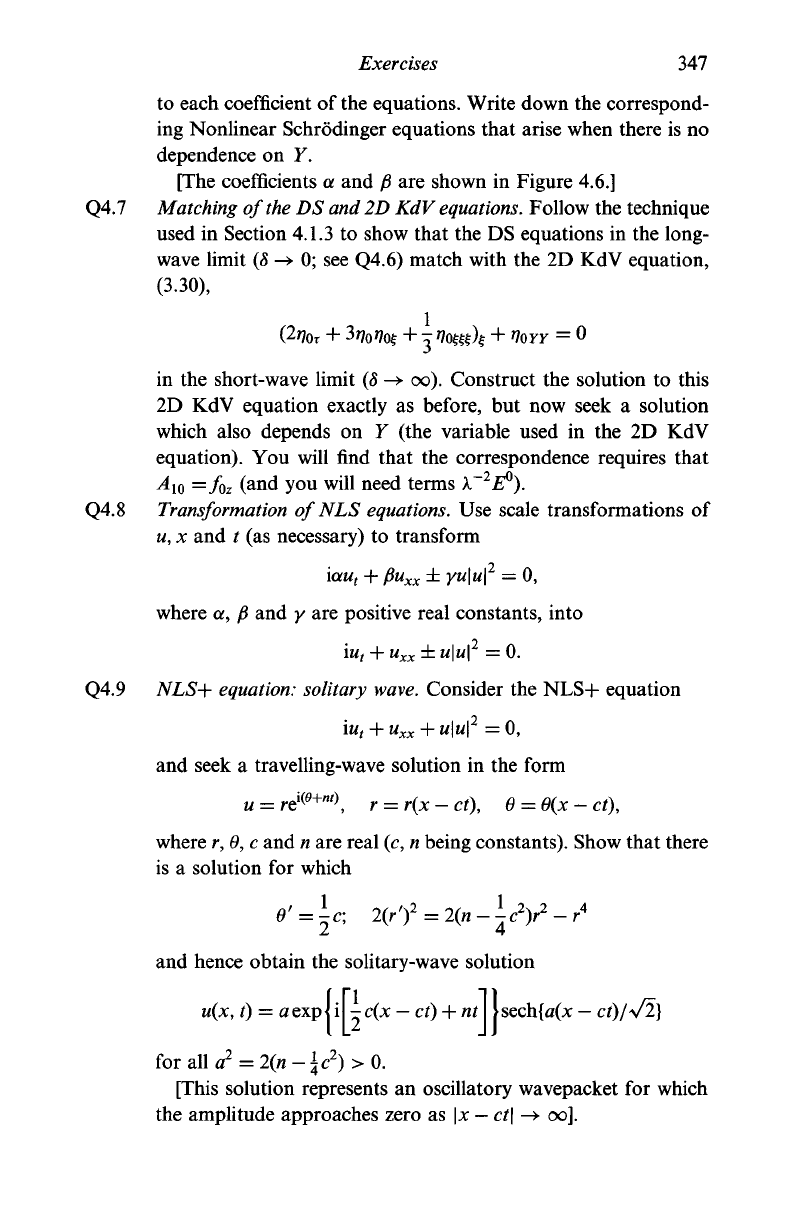
Exercises
347
to each coefficient of the equations. Write down the correspond-
ing Nonlinear Schrodinger equations that arise when there is
no
dependence
on
Y.
[The coefficients
a
and
f$
are shown
in
Figure 4.6.]
Q4.7 Matching of the
DS
and 2D KdV equations. Follow the technique
used
in
Section 4.1.3
to
show that the DS equations
in
the long-
wave limit (8
-> 0;
see Q4.6) match with the 2D KdV equation,
(3.30),
(2rj
0r
+
3?to*to$
+
^
*7og$)$
+
VOYY
=
0
in the short-wave limit (8
->
oo). Construct the solution
to
this
2D KdV equation exactly
as
before,
but
now seek
a
solution
which also depends
on Y
(the
variable used
in
the 2D KdV
equation). You will find that
the
correspondence requires that
A
xo
=foz (and you will need terms A~
2
2s°).
Q4.8 Transformation
of NLS
equations. Use scale transformations
of
M,
x
and
t
(as necessary)
to
transform
\au
t
+ Pu
xx
±yu\u\
2
=
0,
where
a,
f$
and
y
are positive real constants, into
\u
t
+
u
xx
±
u\u\
2
=
0.
Q4.9 NLS+ equation: solitary wave. Consider the NLS+ equation
i«/
+
u
xx
+ u\u\
2
=
0,
and seek
a
travelling-wave solution
in
the form
r
=
r(x-ct),
0 =
0(x-ci),
where
r,
6, c and n are real (c, n being constants). Show that there
is
a
solution
for
which
and hence obtain the solitary-wave solution
w(x, t)
=
aexpj i
-C(JC
-
ct)
+
nt |sech{a(x
-
ct)/V2}
for alia
2
= 2(n-\c
2
)>0.
[This solution represents
an
oscillatory wavepacket
for
which
the amplitude approaches zero
as
\x
—
ct\
->
oo].

348 4 Slow modulation of dispersive waves
Q4.10 NLS- equation: solitary wave. Follow the procedure described in
Q4.9,
but now for the NLS- equation
\u
t
+ u
xx
- u\u\
2
= 0.
Show that there exists a solution for which
r
2
= -n - 2a
2
sech
2
0£), 0 = - arctanI — tanh(a£) I,
I
c
J
where
%
= x
—
ct, for all c and a = \
y/—2n
—
c
2
, provided
n <
—
\c
2
. What is the behaviour of this solution as |£| -> oo?
[This solution is sometimes called a dark solitary wave because
it describes a depression in a non-zero background state; it is not
relevant in water-wave problems when there is no disturbance at
infinity.]
Q4.ll NLS+ equation: the Ma solitary wave. Show that the NLS+
equation in Q4.9 has a solution
, , ,.
2
Jt /
2m(racos0
+
i«sin0)
\]
u(x, t) = aexp(ia
2
t)\
1
+
K
—
7
=- '- ,
I \n cosh(mflV 2x) + cos 0/ J
for all real a and m, where n
2
= 1 + m
2
and 0 = 2mna
2
t. What is
the behaviour of this solution as
|JC|
-> oo?
[Note that this solution does not represent a travelling wave;
see Ma(1979), Peregrine (1983) and Figure 4.3.]
Q4.12 A rational-cum-oscillatory solution. Show that the NLS+
equation in Q4.9 has the solution
u(x, t) = Q
[t
{\ - 4(1 + 2if)/(l + 2x
2
+
At
2
)}.
[This solution contains no free parameters, but see Q4.14 and
Q4.15;
this is not a travelling wave, as Figure 4.3 makes clear.]
Q4.13 Behaviour of the Ma solitary wave. Obtain the asymptotic beha-
viour of the Ma solitary wave (Q4.ll) as m -> oo at fixed a.
Retain terms of O(l) and O(m), and regard mx = O(l).
Q4.14 A normalised Ma solution. Show that the solution in Q4.11 can be
'normalised' by the removal of the amplitude a, under the trans-
formation x -> x/a, t -> t/a
2
, u -> au. Further, confirm that the
NLS equation is invariant under this same transformation; see
Q4.16.
Q4.15 Ma ->• rational-cum-oscillatory. For the solution given in Q4.ll,
set a—\ and choose n
—
—
y/l
+m
2
. Now let m -> 0 (for x
and t fixed) and hence recover the solution in Q4.12. Repeat
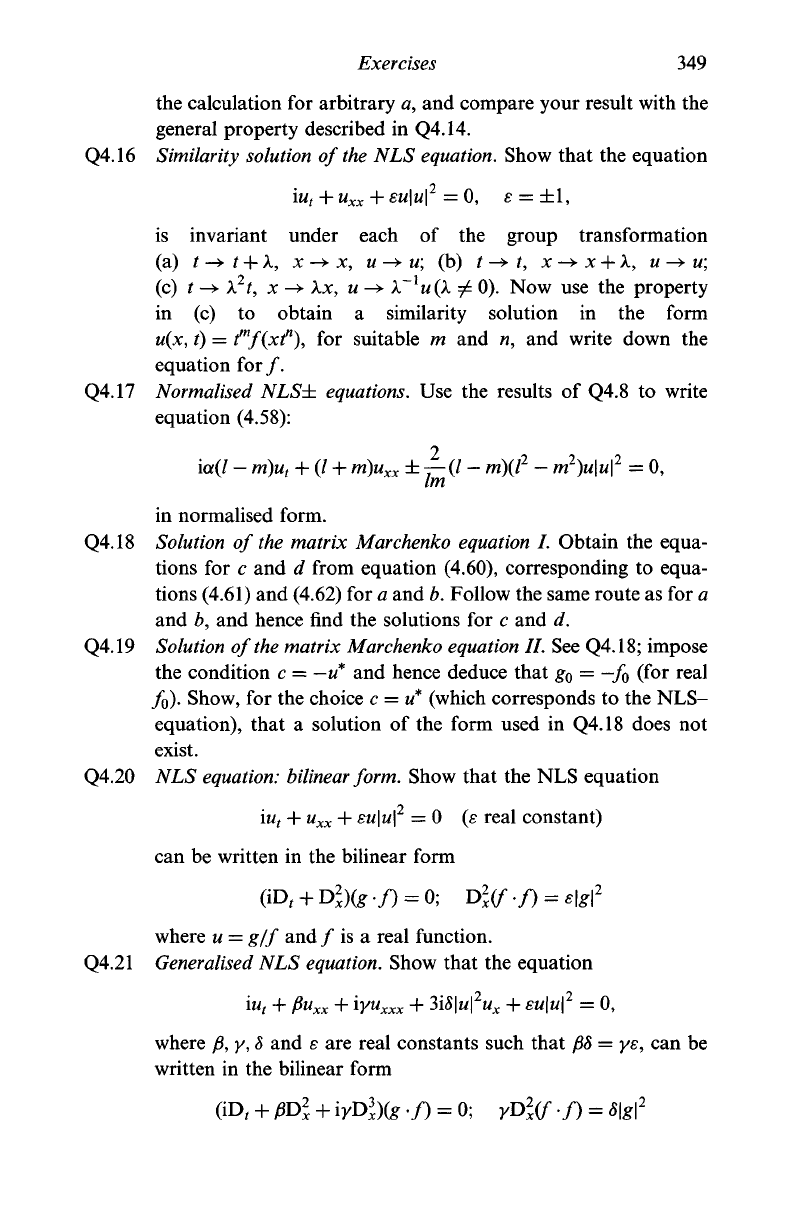
Exercises 349
the calculation for arbitrary a, and compare your result with the
general property described in Q4.14.
Q4.16 Similarity solution of the NLS equation. Show that the equation
\u
t
+ u
xx
+ su\u\
2
= 0, e = ±l,
is invariant under each of the group transformation
(a) t -> t + k, x -> x
9
u -+ u; (b) t -> t, x
->•
x +
A,
w
-• w;
(c) / ~> A.
2
£,
JC
->
AJC,
M
-> k~
l
u{k ^ 0). Now use the property
in (c) to obtain a similarity solution in the form
u(x, i) = t
m
f(xf), for suitable m and n, and write down the
equation for /.
Q4.17 Normalised NLS± equations. Use the results of Q4.8 to write
equation (4.58):
ia(l - m)u
t
+ (/ + m)u
xx
± ^-
(I
- m)(l
2
- m
2
)u\u\
2
= 0,
in normalised form.
Q4.18 Solution of the matrix Marchenko equation I. Obtain the equa-
tions for c and d from equation (4.60), corresponding to equa-
tions (4.61) and (4.62) for a and b. Follow the same route as for a
and b, and hence find the solutions for c and d.
Q4.19 Solution of
the
matrix Marchenko equation II. See Q4.18; impose
the condition c = — u* and hence deduce that g
0
= —/
0
(for real
fo).
Show, for the choice c =
u*
(which corresponds to the NLS-
equation), that a solution of the form used in Q4.18 does not
exist.
Q4.20 NLS equation: bilinear form. Show that the NLS equation
\u
t
+ u
xx
+ eu\u\
2
—
0 {e real constant)
can be written in the bilinear form
(iD,
+ D
2
)(g •/) = 0; D
2
x
(f •/) = s\g\
2
where u = g/f and / is a real function.
Q4.21 Generalised NLS equation. Show that the equation
\u
t
+ fiu
xx
+ iyu
xxx
+ 3i8\u\
2
u
x
+ eu\u\
2
= 0,
where p, y, 8 and s are real constants such that
/38
= ye, can be
written in the bilinear form
(iD,
+ £D
2
+ iyD
3
x
)(g •/) = 0; yD
2
x
(f •/) = 8\g\
2
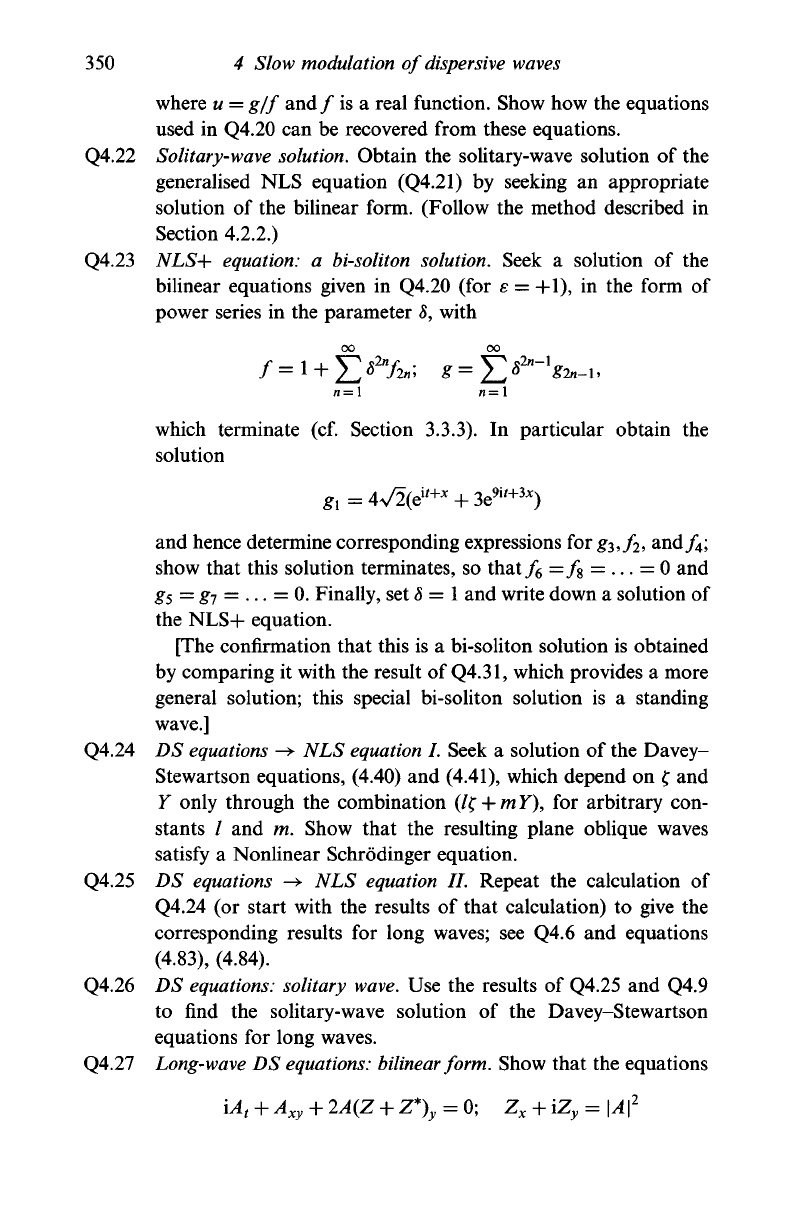
350 4
Slow modulation
of
dispersive waves
where u = g/f and/ is a real function. Show how the equations
used in Q4.20 can be recovered from these equations.
Q4.22 Solitary-wave solution. Obtain the solitary-wave solution of the
generalised NLS equation (Q4.21) by seeking an appropriate
solution of the bilinear form. (Follow the method described in
Section 4.2.2.)
Q4.23 NLS+ equation: a bi-soliton solution. Seek a solution of the
bilinear equations given in Q4.20 (for e = +1), in the form of
power series in the parameter 8, with
n=l n=\
which terminate (cf. Section 3.3.3). In particular obtain the
solution
gl
= 4x/2(e
i/+
* + 3e
9i
'
+3
*)
and hence determine corresponding expressions for #3,/2, and/
4
;
show that this solution terminates, so that/
6
=/
8
= ... = 0 and
g
5
= g
7
= ... =0. Finally, set
8
=
1
and write down a solution of
the NLS+ equation.
[The confirmation that this is a bi-soliton solution is obtained
by comparing it with the result of
Q4.31,
which provides a more
general solution; this special bi-soliton solution is a standing
wave.]
Q4.24 DS equations -> NLS equation I. Seek a solution of the Davey-
Stewartson equations, (4.40) and (4.41), which depend on £ and
Y only through the combination (/f + mY), for arbitrary con-
stants / and m. Show that the resulting plane oblique waves
satisfy a Nonlinear Schrodinger equation.
Q4.25 DS equations -> NLS equation II. Repeat the calculation of
Q4.24 (or start with the results of that calculation) to give the
corresponding results for long waves; see Q4.6 and equations
(4.83),
(4.84).
Q4.26 DS
equations:
solitary wave. Use the results of Q4.25 and Q4.9
to find the solitary-wave solution of the Davey-Stewartson
equations for long waves.
Q4.27 Long-wave DS
equations:
bilinear
form.
Show that the equations
\A
t
+ A
xy
+ 2A(Z + Z*)
y
=
0;
Z
x
+ iZ
y
= \A\
2

Exercises 351
(see (4.88)) can be written in the bilinear form
(iD,
+ D
x
D
y
)(g •/) = 0;
(D
2
X
+ D
2
y
)(f •/) =
2
where A = g/f and
z=
fi._
i
l
2
\dx dy
for/ real; see equations (4.89).
Q4.28 DS
bilinear
form: solution. Obtain the solitary-wave solution of
the pair of bilinear equations given in Q4.27; see equation (4.90).
Q4.29 Long-wave DS
equations:
solitary
wave.
Show that your solutions
obtained in Q4.28 and Q4.26 are equivalent.
Q4.30 NLS+ equation: 2-soliton solution. Use the bilinear form of the
NLS+ equation (given in Q4.20) to obtain the 2-soliton solution
of that equation; see equations (4.79), (4.80), et seq.
Q4.31 NLS+ equation: bi-soliton solution. From the 2-soliton solution
obtained in Q4.30, construct the bi-soliton (or bound soliton)
solution by choosing the two speeds to be equal (that is,
c
x
= c
2
); see equation (4.81) et seq., and Figure 4.5.
Q4.32 NLS equation: two conservation laws. Show that the NLS
equation
possesses conserved quantities
oo
oo
f
(\u
x
\
2
~\e\uf)&x,
J
{uu*
x
xxx
+
3
-s\u\
2
uu*
x
)dx.
—00
Q4.33 NLS equation: a special conservation law. Show that the NLS
equation in Q4.32 has the conservation law
oo
/
{ix|w|
2
-
t(u*u
x
-
MM*)}
dx =
constant.
Q4.34 NLS equation: conservation of momentum. Show that the
conservation law
00
/
(UU
X
-
U*U,
)
dx = constant

352 4 Slow
modulation
of
dispersive waves
corresponds to the leading term in the expression for the con-
servation of momentum in the wave motion; see equations (4.96)
and (3.92).
Q4.35 DS
equations:
special conservation
laws.
Given the DS equation
written as
-iaA
t
+
fiA
xx
-
yA
yy
+
8A\A\
l
+ Af
x
= 0,
where
A,
/x,
a,
P,
y and 8 are real constants, and given that
OO
OO
/ \A\
2
dx and / \A\
2
dy
are constant, consider the following:
(a) What are the forms of
OO
OO
[ (A*A
y
-AA*
y
)dx and f
(A*A
X
-
AA*
x
)dyl
—OO
—OO
(b) Are there conditions under which the two expressions in (a)
are constants?
(c) What is the form of J^fdyl
(d) Are there conditions under which the expression in (c) is
constant? If so, what is this constant?
Q4.36 DS
equations:
conservation
laws.
Show, provided solutions of the
equations given in Q4.35 decay sufficiently rapidly as
x
2
+ y
2
-> oo, that two constants of the motion are
OO
OO OO
j(AA
x
-A*A
x
)dxdy; f J
(AA*
y
-
A*A
y
)dxdy.
—oo —oo —oo —oo
Q4.37 A 2D NLS equation. A two-dimensional NLS+ equation is
\u
t
+ u
xx
+ u
yy
+
u\u\
2
= 0;
obtain the plane solitary-wave solution of this equation; see
Q4.9.
[This equation is a natural two-dimensional variant of the
NLS equation; for more details in this direction, see Hui &
Hamilton (1979) and Yuen & Lake (1982).]

Exercises
353
Q4.38 2D
NLS
equation:
conservation
laws. Show that, with suitable
decay conditions
at
infinity, solutions
of
the two-dimensional
NLS-h equation given
in
Q4.37 possess the following conserved
quantities:
oo
oo oo
J \u\
2
dxdy;
j j
\\u
x
\
2
+ \u
y
\
2
-
X
-\u\
A
—oo
—oo —oo —oo
Q4.39 NLS
equation:
moment
of
inertia.
For the NLS equation given in
Q4.32,
define the moment
of
inertia
oo
/=
I
x
2
\u\
2
dx
— 00
and hence show that
oo
^-./[W-J^dx.
dt
2
which is not
a
constant
of
the motion (see Q4.32).
Q4.40 Another
solution
of
the
NLS
equation.
Obtain
a
solution
of
the
equation
\u
t
-h u
xx
+
eu\u\
2
=
0 (s = ±1)
in the form
u(x, i) =
A(x)exp(icot),
where
co
is
a
real constant. Write down the equation for A(x) and
hence obtain, under suitable conditions that should be stated, the
solution
for
which
(a)
A is a
sech
function
if
£
= +1;
(b)
A is a
tanh function
if
£
=
—
1.
[See,
for
example, Hasimoto & Ono (1972).]
Q4.41 Another
representation
of
the
NLS
equation.
Seek
a
solution
of
the NLS equation given
in
Q4.40
in
the form
X
u(x, i) = A(x, f)exp(i
/ k(x\
i)dx'),
where both
A and k are
real functions. Obtain
the
two (real)
equations that together describe
A and k, and
show that each
